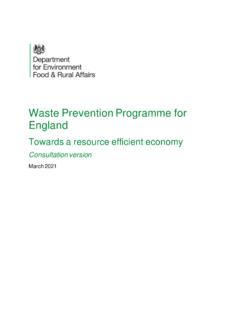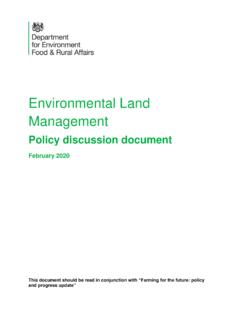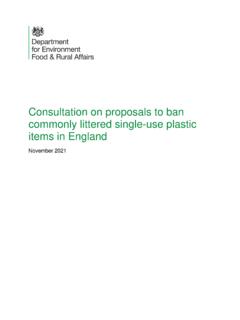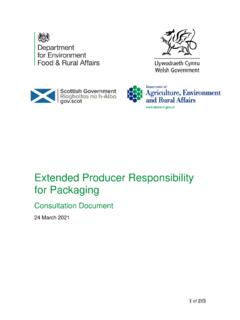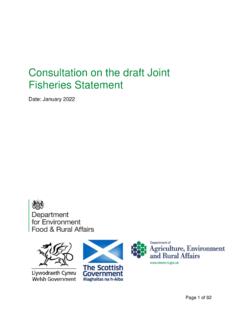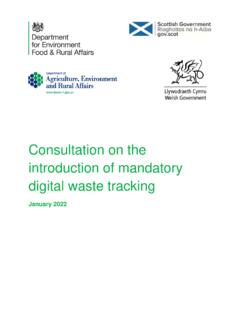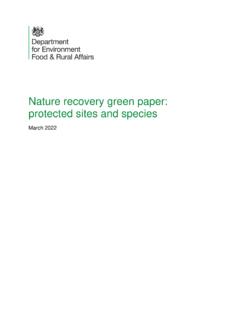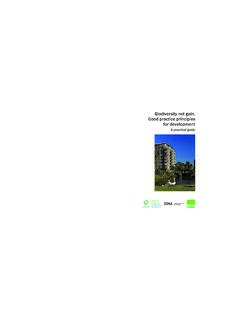Transcription of Consultation on Biodiversity Net Gain Regulations and ...
1 Consultation on Biodiversity Net gain Regulations and Implementation January 2022. 1 of 109. We are the Department for Environment, Food and Rural Affairs. We're responsible for improving and protecting the environment, growing the green economy, sustaining thriving rural communities and supporting our world-class food, farming and fishing industries. We work closely with our 33 agencies and arm's length bodies on our ambition to make our air purer, our water cleaner, our land greener and our food more sustainable. Our mission is to restore and enhance the environment for the next generation, and to leave the environment in a better state than we found it. Crown copyright 2021. This information is licensed under the Open Government Licence To view this licence, visit This publication is available at Any enquiries regarding this publication should be sent to us at: Consultation on Biodiversity Net gain Regulations and Implementation Consultation Coordinator, Defra 2nd Floor, Foss House Kings Pool 1-2 Peasholme Green York YO1 7PX.
2 2 of 109. How to respond Consultation questions are included in Parts 1, 2 and 3 of this document. Please respond by 5th April 2022. Please respond through the online survey (Citizen Space) accessible via Responses can also be sent by email to or by post, specifying which questions you are responding to: Consultation on Biodiversity Net gain Regulations and Implementation Consultation Coordinator, Defra 2nd Floor, Foss House, Kings Pool 1-2 Peasholme Green York YO1 7PX. This Consultation is in line with the UK Government's Consultation Principles. This can be found on Representative groups are asked to give a summary of the people and organisations they represent and where relevant who else they have consulted in reaching their conclusions when they respond. Confidentiality and data protection information A summary of responses to this Consultation will be published on An annex to the Consultation summary will list all organisations that responded but will not include personal names, addresses or other contact details.
3 Defra may publish the content of your response to this Consultation to make it available to the public without your personal name and private contact details (for example, home address, email address). If you click on Yes' in response to the question asking if you would like anything in your response to be kept confidential, you are asked to state clearly what information you would like to be kept as confidential and explain your reasons for confidentiality. The reason for this is that information in responses to this Consultation may be subject to release to the public or other parties in accordance with the access to information law (these are primarily the Environmental Information Regulations 2004 (EIRs), the Freedom of Information Act 2000 (FOIA) and the Data Protection Act 2018 (DPA)). 3 of 109. We have obligations, mainly under the EIRs, FOIA and DPA, to disclose information to particular recipients or to the public in certain circumstances. In view of this, your explanation of your reasons for requesting confidentiality for all or part of your response would help us balance these obligations for disclosure against any obligation of confidentiality.
4 If we receive a request for the information that you have provided in your response to this Consultation , we will take full account of your reasons for requesting confidentiality of your response, but we cannot guarantee that confidentiality can be maintained in all circumstances. If you click on No' in response to the question asking if you would like anything in your response to be kept confidential, we will be able to release the content of your response to the public, but we won't make your personal name and private contact details publicly available. There may be occasions when Defra will share the information you provide in response to the Consultation , including any personal data with external analysts. This is for the purposes of Consultation response analysis and provision of a report of the summary of responses only. Please find our latest privacy notice uploaded as a related document alongside our Consultation document. If you have any comments or complaints about the Consultation process, please address them to: Consultation on Biodiversity Net gain Regulations and Implementation Consultation Coordinator, Defra 2nd Floor, Foss House, Kings Pool 1-2 Peasholme Green York YO1 7PX.
5 Or email: 4 of 109. Contents How to respond . Introduction . Background . Why are we consulting? . The context for Biodiversity net gain . Overview of the proposed Biodiversity net gain processes . Part 1: defining the scope of the Biodiversity net gain requirement for Town and Country Planning Act 1990 development . Exemptions . Development within statutory designated sites for nature conservation . Irreplaceable habitat . Part 2: Applying the Biodiversity gain objective to different types of development . Phased development and development subject to subsequent applications . Small sites . Nationally Significant Infrastructure Projects . Part 3: How the mandatory Biodiversity net gain requirement will work for Town and Country Planning Act 1990 development . Biodiversity gain plan . Off-site Biodiversity gains . The market for Biodiversity units . Habitat banking . The Biodiversity gain site register . Additionality . 5 of 109. Statutory Biodiversity credits.
6 Reporting, evaluation, and monitoring . Glossary . Annex A: Other policies and objectives which interact with Biodiversity net gain . Annex B: Biodiversity gain plan template (working draft) . Annex C: Reporting requirements . 6 of 109. Introduction What is Biodiversity net gain ? Biodiversity net gain is an approach to development which means that habitats for wildlife must be left in a measurably better state than they were in before the development. Achieving Biodiversity net gain means that natural habitats will be extended or improved as part of a development or project. Development will be designed in a way that provides benefits to people and nature and reduces its impacts on the wider environment. Mandating Biodiversity net gain through the Environment Act will establish a consistent set of requirements and necessary exemptions which give developers clarity as to how they can meet their net gain obligations. The existing strong statutory and policy protections for our statutory protected sites, and protected species, will not be undermined or replaced by the Environment Act's Biodiversity net gain measures.
7 A proposal to deliver Biodiversity net gain does not affect the weight that should be given to other planning considerations, matters of planning policy, or legal obligations including those relating to protected sites, protected species and irreplaceable habitats. What we are already doing? What will mandatory Biodiversity net gain add? Protected by current legislation and planning policy: Protected by current legislation and planning policy: Statutory protected sites Statutory protected sites Protected and important species Protected and important species Irreplaceable habitats Irreplaceable habitats . Important habitats, such as native woodland, are Important habitats, such as native woodland, are afforded protection through planning policy only. afforded protection through planning policy and Sometimes compensation is provided for their loss, Biodiversity net gain . Losses of important habitats depending on case circumstances and local must be compensated with creation or planning policy.
8 Enhancement of the same habitat type.. Other habitats, such as scrub, will have their Other habitats, such as scrub, may be recognised Biodiversity value recognised, encouraging the in local planning policy. They are sometimes, but avoidance of impacts and meaning losses must be often not, subject to compensation requirements. compensated. Figure 1: What mandatory Biodiversity net gain adds to existing legislation and planning policy 7 of 109. What are we consulting on? We are consulting on the practical and legal implementation details of the new Biodiversity net gain requirement for development. Targeted stakeholder engagement will take place during and after this Consultation to finalise any outstanding technical implementation and policy details. This will include a formal Consultation on the Biodiversity metric before it is published for use in mandatory Biodiversity net gain . It is important to note that the Biodiversity net gain plan template included in Annex B is a draft and will be subject to further testing with stakeholders before a final version is published.
9 Consultation questions are split into three parts, each of which covers several themes: 1) defining the scope of the Biodiversity net gain requirement for Town and Country Planning Act 1990 development exemptions development within statutory designated sites for nature conservation irreplaceable habitat 2) applying the Biodiversity gain objective to different types of development phased development and development subject to subsequent applications small sites Nationally Significant Infrastructure Projects (NSIPs). 3) how the mandatory Biodiversity net gain requirement will work for Town and Country Planning Act 1990 development Biodiversity gain plan off-site Biodiversity gains the market for Biodiversity units habitat banking the Biodiversity gain site register additionality statutory Biodiversity credits reporting, evaluation, and monitoring Background The UK Government is committed to improving the environment, benefitting local communities, and delivering sustainable development.
10 The 25 Year Environment Plan sets 8 of 109. out how the UK Government intends to deliver its promise to leave the environment in a better state than we inherited it. In 2018, we consulted on making Biodiversity net gain mandatory for new development1. through the planning system. The responses indicated broad support for our proposals and the UK Government included provisions for mandatory Biodiversity net gain in the Environment Act2. These provisions will help to make Biodiversity a prominent consideration in development and are expected to generate a market for Biodiversity units worth around 135 million3,4. The Act sets out the framework for Biodiversity net gain requirements whilst leaving some detail to be provided through secondary legislation, policy, and guidance. The Environment Act's Biodiversity net gain provisions apply: for development for which planning permission is granted under the Town and Country Planning Act 1990, a new planning condition for net gain that must be met before development may commence for Nationally Significant Infrastructure Projects consented under the Planning Act 2008, a new requirement to meet a Biodiversity net gain objective.
